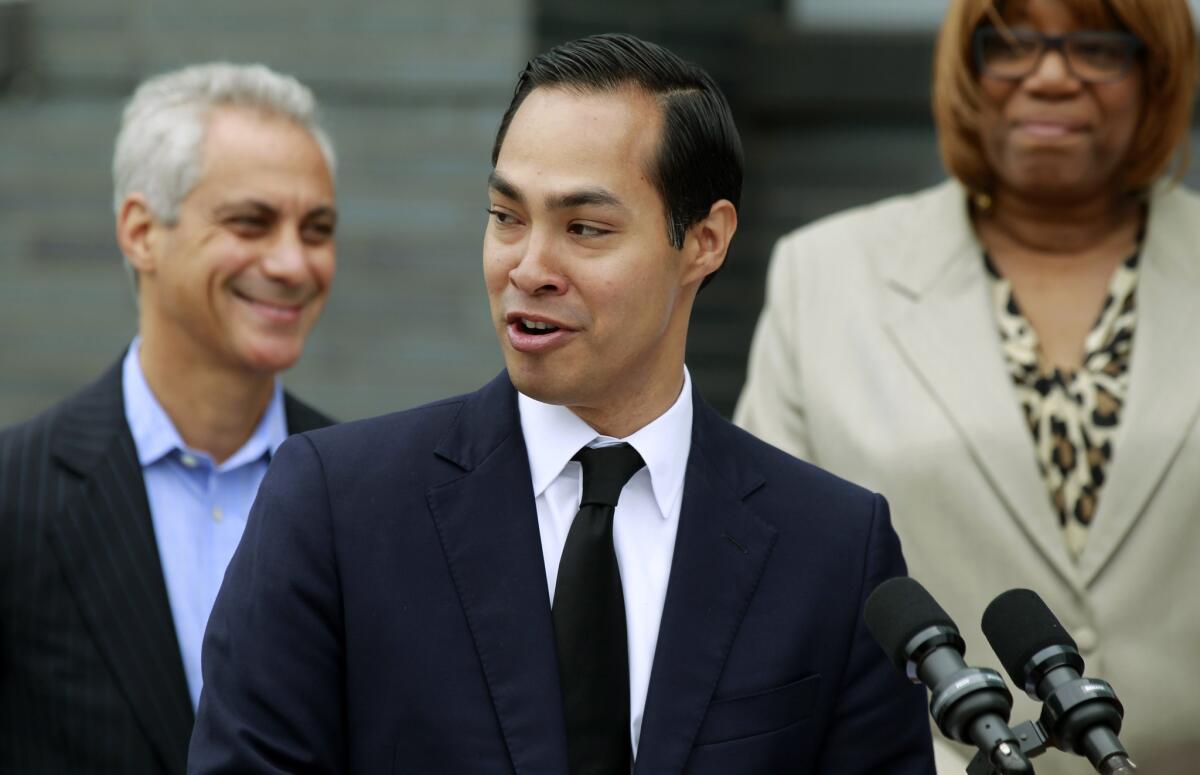Op-Ed: America’s fair housing backlash

Housing and Urban Development Secretary Julian Castro announces a policy change at a news conference in Chicago July 8. The new rules provide guidance to help cities achieve the promises of the 1968 Fair Housing Act by promoting racially integrated neighborhoods.
If you’ve read conservative blogs or magazines in the last month, you’ve probably seen something like this headline from Townhall — “HUD’s ‘Disparate Impact’ War on Suburban America” — or this one from National Review — “Attention America’s Suburbs: You Have Just Been Annexed.”
Behind this dramatic language, not to say fear-mongering, are recent decisions from the Supreme Court and the Department of Housing and Urban Development that take aim at residential segregation.
In June, a 5-4 Supreme Court majority upheld a central tool of the 1968 Fair Housing Act — disparate impact — which allows the government to file claims to end racial disparities in housing access, even if they aren’t linked to outright discrimination.
This was a surprise. Two years earlier, the court had invalidated a key part of the Voting Rights Act of 1965. “Our country has changed,” wrote Chief Justice John G. Roberts Jr. in his majority opinion. “While any racial discrimination in voting is too much, Congress must ensure that the legislation it passes to remedy that problem speaks to current conditions.”
For the Roberts court, “current conditions” has often meant solutions that don’t involve race. Most observers thought this would also be true of the Fair Housing Act, but they were wrong.
Less surprising but still important are new rules from HUD meant to implement a long-neglected part of the Fair Housing Act. Per the law, the federal government is required to “affirmatively” further fair housing. If a community is heavily segregated, then it has to reduce that segregation to qualify for federal funds.
As HUD secretary starting in 1969, George Romney tried to do just that. But conflicts with President Nixon — who opposed the “forced integration of housing” — pushed him out of the administration. Since then, the “affirmative” part of fair housing has withered on the vine.
The new rules are meant to reinvigorate it. Under the initiative, HUD would provide local governments with information on “segregated living patterns” and “racially or ethnically concentrated areas of poverty.” To encourage action — whether new affordable housing in affluent areas and zoning rules to promote integration or better services in poor neighborhoods — the agency would offer grant money. “We know where you live matters,” said current HUD Secretary Julian Castro. “Children who live in good neighborhoods do much better than those who are stuck in poverty.”
Housing advocates are thrilled with these changes. But how will white Americans react to an active effort to integrate their neighborhoods? Past experience suggests that they’ll resist.
Historically, housing was ground zero for the toughest battles of the civil rights era. White Americans who supported school integration and voting rights would refuse to open their neighborhoods to black Americans and other minorities. Banks that served white communities denied loans to minority home buyers, white authorities practiced exclusionary zoning, and public housing was intentionally placed in segregated areas to keep people of color out of desirable neighborhoods. If Nixon was hostile to Romney’s push for fair housing, it was part conviction and part political necessity.
Most white Americans today are racial egalitarians. Still, old patterns persist. In study after study, white Americans show a strong preference for white neighborhoods, rating mixed-race or African American neighborhoods as less desirable, even when the homes are just as nice, the schools are just as good and the streets are just as safe. According to the 2008 General Social Survey — the gold standard for public opinion — 20% of whites said their ideal neighborhood was all white, while 25% said it was mixed-race but had no blacks.
This time around, no one will defend the principle of white-only or rich-only neighborhoods. Resistance will mount, instead, against attempts to change the “character” of existing neighborhoods or against policies that threaten local control. In the aforementioned piece in National Review, columnist Stanley Kurtz wrote, “The regulation amounts to back-door annexation, a way of turning America’s suburbs into tributaries of nearby cities.”
Some communities might even revolt against the politicians who push and approve of new zoning or building rules. As Thomas Edsall noted in a July 15 column for the New York Times, a HUD mandate in liberal Westchester County, N.Y., was politically lucrative for Republicans in the 2009 and 2013 local elections. They won, and held, the county executive seat, with their strongest margins in the mostly white towns where HUD required affordable housing.
For most of the 20th century, state and local governments — with federal backing — carved America’s landscape into white-only and black-only areas. In cities such as New York; Newark, N.J.; Philadelphia; Baltimore; Cleveland; Detroit; St. Louis; Madison, Wis.; Minneapolis and many others, minorities were kept from owning good homes, attending good schools and earning their piece of American prosperity. With exclusionary zoning and racist lending, we kept millions of people from opportunity, while taking their taxes for services they couldn’t enjoy.
Far from social engineering or an “annexation,” affirmative fair housing rules constitute a modest effort to rectify a real and ongoing injustice. With any luck, affluent Americans will see that they’ve been on the most fortunate side of history, and that it’s time to pay it forward.
Jamelle Bouie is a staff writer for Slate.
Follow the Opinion section on Twitter @latimesopinion and Facebook
More to Read
A cure for the common opinion
Get thought-provoking perspectives with our weekly newsletter.
You may occasionally receive promotional content from the Los Angeles Times.






